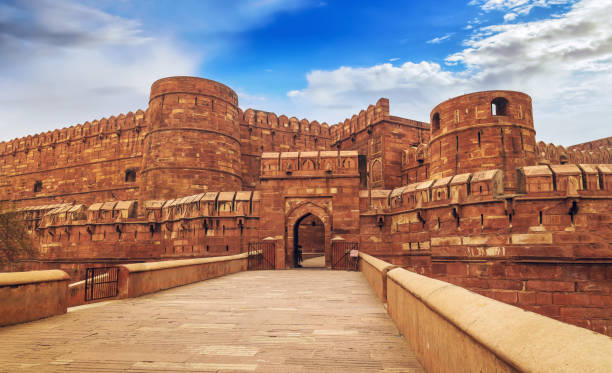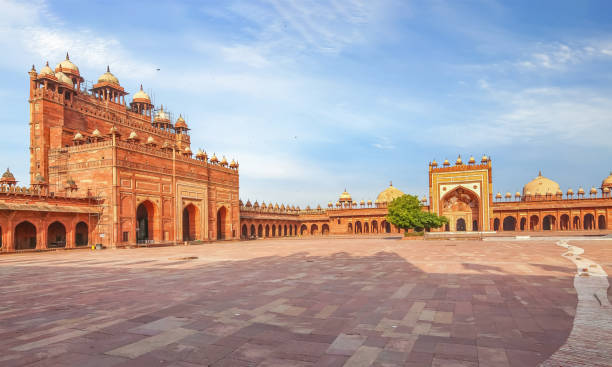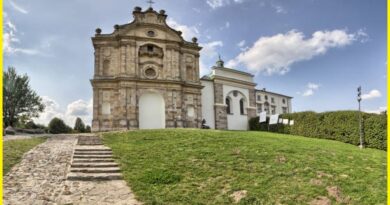Beyond the Magnificence- A Tale of ‘Fatehpur Sikri’
Fatehpur Sikri
Fatehpur Sikri is a historical city in the Agra District of Uttar Pradesh, India. It was founded in the 16th century by Emperor Akbar, the great Mughal ruler, in 1569. The city served as the capital of the Mughal Empire for about 14 years, from 1571 to 1585. The complex of monuments, all in a uniform architectural style, includes one of the largest mosques in India, the Jama Masjid. It was constructed southeast of an artificial lake, on the slopping levels of the outcrops of the Vindhyan hill ranges. Known as the “city of victory”, it was made capital by the Mughal emperor Akbar (r. 1556-1605 CE) and constructed between 1571 and 1573. Fatehpur Sikri was the first planned city of the Mughals to be marked by magnificent administrative, residential, and religious buildings comprised of palaces, public buildings, mosques, and living areas for the court, the army, the servants of the king and an entire city. Upon moving the capital to Lahore in 1585, Fatehpur Sikri remained an area for temporary visits by the Mughal emperors.
The city, which is bounded on three sides by a wall 6 km long fortified by towers and pierced by nine gates, includes several impressive edifices of secular and religious nature that exhibit a fusion of prolific and versatile Indo-Islamic styles. The city was originally rectangular in plan, with a grid pattern of roads and by-lanes which cut at right angles, and featured an efficient drainage and water management system. The well-defined administrative block, royal palaces, and Jama Masjid are located in the center of the city.
Geology
Fatehpur Sikri sits on a rocky ridge, 3 kilometers in length and 1 km wide, and the palace city is surrounded by a 6 km wall on three sides with the fourth bordered by a lake. The city is generally organized around this 40 m high ridge and falls roughly into the shape of a rhombus. The dynastic architecture of Fatehpur was modeled on Timurid forms and styles. The city was built massively and preferably with red sandstone. Gujarati influences are also seen in the architectural vocabulary and decor of the palaces of Fatehpur.

It is accessed through gates along the 8.0 km long fort wall, namely, Delhi Gate, the Lal Gate, the Agra Gate and Birbal’s Gate, Chandanpal Gate, The Gwalior Gate, the Tehra Gate, the Chor Gate, and the Ajmeri Gate. The palace contains summer palace and winter palace for Queen Mariam-uz-Zamani commonly known as Jodha Bai.
Also Read- Geotourism around the Tajmahal, India Dream destination
Fatehpur Sikri Fort
Fatehpur Sikri, often referred to as a “fort” due to its fortified appearance, is a historical city and palace complex rather than a traditional fort. The site was chosen strategically for its proximity to the city of Agra and its auspicious location. Fatehpur Sikri Fort is renowned for its architectural grandeur and cultural significance. The city showcases a blend of Persian, Indian, and Islamic architectural styles. The structures within Fatehpur Sikri are remarkably well-preserved, offering visitors insights into the luxury and sophistication of Mughal architecture during Akbar’s reign.
While Fatehpur is not a typical fort with high defensive walls and military structures, it does possess elements of fortification in its design. The city was planned with defensive considerations in mind, with walls and gates providing security, though its primary purpose was as a royal residence and administrative center.
The complex includes various palaces, mosques, tombs, and administrative buildings, showcasing the architectural brilliance of the Mughal era. Some of the notable structures within Fatehpur include the Buland Darwaza (the grand entrance gate), Jama Masjid (the principal mosque), Diwan-i-Khas (the Hall of Private Audience), Diwan-i-Aam (the Hall of Public Audience), and the Tomb of Salim Chishti.
Fatehpur Sikri History
Places to visit in Fatehpur Sikri
Fatehpur Sikri, a UNESCO World Heritage Site, offers visitors a rich tapestry of historical and architectural wonders from the Mughal era. Here are some of the key places to visit in Fatehpur Sikri.
Buland Darwaza
This grand gateway, also known as the “Gate of Magnificence,” is one of the most iconic structures in Fatehpur Sikri. It was built by Emperor Akbar to commemorate his victory over Gujarat and stands as a testament to the Mughal architectural grandeur.
Tomb of Salim Chishti
This white marble tomb is dedicated to the Sufi saint Salim Chishti, whom Emperor Akbar highly revered. The tomb is a popular pilgrimage site and is believed to fulfill the wishes of devotees who visit it.
Diwan-i-Khas and Diwan-i-Aam
These were the halls of private and public audiences, respectively, where Emperor Akbar held meetings with his courtiers and addressed public matters. The Diwan-i-Khas is particularly notable for its central pillar, which is believed to have been Akbar’s throne.
Panch Mahal
The Panch Mahal is a five-story palace with open pavilions and intricately carved columns. It served as a retreat for the royal women of the Mughal court and offered panoramic views of Fatehpur Sikri.
Jama Masjid
The Jama Masjid of Fatehpur Sikri is one of the largest mosques in India. Its massive courtyard and intricately designed prayer halls reflect the architectural prowess of the Mughal era.

Anup Talao
This ornamental pool is situated in front of the Diwan-i-Khas and was used for musical performances and other royal events during the Mughal period.
Hiran Minar
Located on the outskirts of Fatehpur Sikri, Hiran Minar is a unique tower built by Emperor Jahangir in memory of his pet deer. The tower offers panoramic views of the surrounding landscape.
Birbal’s House
This residential complex belonged to Birbal, one of Akbar’s closest advisors and courtiers. The architecture of Birbal’s House reflects the fusion of Hindu and Islamic styles.
Things to do in Fatehpur Sikri
While Fatehpur Sikri is primarily known for its historical and architectural landmarks from the Mughal era, there are several activities and experiences that visitors can enjoy during their time in the area. Here are some things to do in Fatehpur Sikri.
Explore the Historical Monuments
Spend time exploring the various historical monuments within Fatehpur, including the Buland Darwaza, Jama Masjid, Tomb of Salim Chishti, Diwan-i-Khas, and Diwan-i-Aam. Marvel at the intricate architecture, learn about their historical significance and take in the grandeur of the Mughal era.
Attend a Light and Sound Show
Many historical sites in Fatehpur offer evening light and sound shows that provide a captivating glimpse into the city’s history and cultural heritage. These shows often feature illuminated monuments accompanied by narrations and music, creating a memorable experience for visitors.
Explore Local Markets
Take a stroll through the local markets and bazaars in Fatehpur Sikri to experience the vibrant atmosphere and discover traditional handicrafts, textiles, jewelry, and souvenirs. Bargain with local vendors and immerse yourself in the colors and flavors of the region.
Visit Nearby Attractions
Explore nearby attractions such as Hiran Minar, a unique tower built by Emperor Jahangir, and the village of Sikri, which offers insights into rural life in India. You can also visit the Keoladeo National Park, a UNESCO World Heritage Site known for its diverse birdlife, located a short distance from Fatehpur Sikri.
Enjoy Local Cuisine
Indulge in the delicious local cuisine of Fatehpur Sikri, which includes Mughlai delicacies such as kebabs, biryanis, and rich curries. Sample street food snacks like samosas, chaat, and jalebis from roadside vendors for a taste of authentic flavors.
How to Reach Fatehpur Sikri
The nearest airport to Fatehpur Sikri is the Agra Airport, also known as Pandit Deen Dayal Upadhyay Airport. It is located about 40 kilometers away from Fatehpur Sikri and offers domestic flight connections to major cities like Delhi, Mumbai, and Jaipur. From the airport, you can hire a taxi or take a bus to reach Fatehpur Sikri. The nearest railway station to Fatehpur Sikri is the Fatehpur Sikri Railway Station, which is well-connected to major cities like Agra, Delhi, Jaipur, and Mathura.

Fatehpur Sikri is well-connected to nearby cities and towns by road. The city of Agra, which is about 36 kilometers away, is the nearest major city. You can reach Fatehpur by road via taxis, private cars, or state-run buses. Agra is also well-connected to other cities like Delhi, Jaipur, and Lucknow via national highways.
Agra to Fatehpur Sikri
The most convenient way to travel from Agra to Fatehpur is by road. The distance between Agra and Fatehpur Sikri is approximately 36 kilometers, and the journey takes about an hour by car or taxi, depending on traffic conditions. You can hire a taxi or rent a car from Agra to Fatehpur. The route is well-connected and well-maintained, making it a comfortable journey.
Another option is to take a bus from Agra to Fatehpur Sikri. There are state-run buses as well as private buses that operate between the two cities. The journey by bus takes approximately 1 to 1.5 hours, depending on the type of bus and the number of stops it makes along the way. You can find buses departing from the Agra Bus Stand to Fatehpur Sikri at regular intervals throughout the day.
While there is a railway station in Fatehpur, it is not a major railway junction, and direct train services from Agra to Fatehpur Sikri are limited. Therefore, traveling by train may not be the most convenient option for this route.




